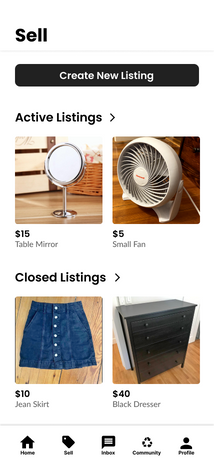Context
This project was completed over the course of one semester at Tufts University with two other human factors master’s students as our master’s capstone project.
Overview
For this project, we designed a goods exchange platform for members of the Tufts community. Our initial goal was to figure out a way to improve sustainability at tufts. After meeting with the recycling and waste reduction coordinator of Tufts, we learned that one of the biggest waste issues at Tufts stemmed from people not knowing what to do with their unwanted goods when moving out at the end of the year. We figured that by creating this goods exchange platform, we could provide an outlet for unwanted goods not just during the move-out periods, but throughout the entire year. In creating such a platform, we would hope to increase sustainability at Tufts while also providing a useful service for students and staff.
Key Research Question:
Why don't existing solutions work?
There are many programs/platforms currently in place that attempt to solve the unnecessary waste of goods (including Tufts reuse programs and online buy/sell platforms like Facebook Marketplace). However, the problem of waste still remains. What is it about these existing solutions that are causing people to not use them? What could be done to improve upon them?
Research Process
.png)
Survey
.png)
Interviews
.png)
Competitive Analysis
We utilized three main research methods to help us understand the problem and reveal the needs of the user. The purpose of the survey was to understand the behavior and experiences of Tufts community members regarding the disposal of goods and the use of existing goods exchange or donation platforms, considering both e-commerce platforms and Tufts reuse programs. We conducted interviews to follow up with survey responses and gain more in-depth insights. Our competitive analysis, which was fueled by our surveys and interviews, as well as other research, helped us to identify the best parts of current solutions and also fill in the gaps to create something better.
Affinity Mapping -> User Needs -> Design Requirements -> Feature Ideas


We then collected all the pain points from our surveys and interviews and grouped them based on similarity in an affinity mapping process. Through this process, we were able to identify the most significant issues with existing solutions, which helped us define user needs and design requirements and brainstorm features to solve these issues.
Key Takeaways from Research
Issues with Tufts reuse programs: Slightly disjointed (i.e., no unified, wholistic solution), difficult to search for specific items, many people are unaware of programs, require Tufts as intermediary for transactions
Issues with e-commerce buy/sell platforms: Scammers, ads, unreliable people. People don’t feel as safe interacting with strangers and don’t like the long commutes (especially with heavy items).
Insights toward design: Design should include closed network, robust search and filter functionality, reliability ratings, simple interactions between users, wholistic set of resources on one unified platform
Design Process
Feature Prioritization
.png)
We prioritized all feature ideas that we didn't consider "must-haves" based on impact and effort of implementation. The prioritized list of features helped us in our site mapping and wireframing process.
Site Map

Rapid Iterative Prototyping & Evaluation
With our wireframing/prototyping process, we wanted to go through as many iterations as possible to gain an abundance of feedback and thoroughly refine our concept. This process involved designing wireframes and prototypes in Figma and conducting usability tests with 2-4 participants for each iteration. The rapid iterative prototyping and evaluation method helped us to quickly identify issues and turn them into design changes.
Home Page
Based on User Feedback...
.png)
.png)
.png)
Removed saved items from home screen. Users preferred to see new and more time sensitive information on home screen, like events. Saved items would be better accessed from profile.
Items Page
.png)
.png)

.png)
.png)
Changed filter/category UI from one button to a horizontal scroll. Users felt this option made filters feel more accessible. Additionally, added preselected "for you" filter when user expands for you section from home screen. This informs users that they can deselect this option.
Sell Page

.png)
.png)
Simplified sell page. "Overview" information would be better if accessed through "seller profile" on profile page.
Final Prototype
Impact
The recycling and waste reduction coordinator at Tufts was very excited about our prototype and the concept as a whole. She immediately asked us how we could turn it into a functional app for the Tufts community. Although we, unfortunately, did not have the time to make it a reality in that one semester, we have provided her with the resources and next steps for making it a real platform.








